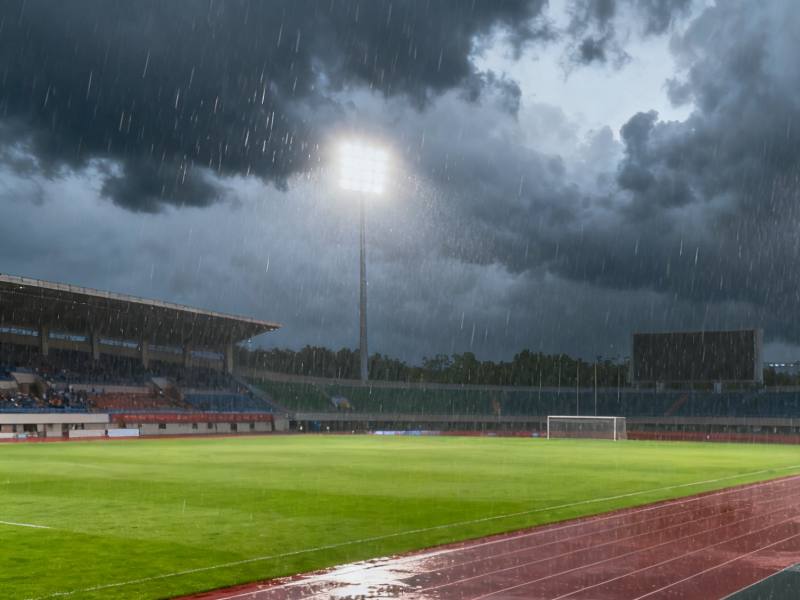The focus of stadium lighting design is the lighting of the playing field, i.e., the competition lighting. Stadium lighting is a highly functional, technically demanding, and challenging design process. It must meet the requirements of various sports competitions, facilitating athletes’ technical performance, referees’ accurate judgments, and the viewing experience from all angles in the stands. Stadium lighting design must pay special attention to live color television broadcasts. To ensure vivid, clear, and realistic images, specific requirements are placed on indicators such as vertical illuminance, illuminance uniformity and three-dimensionality, color temperature of the light source, and color rendering index. Whether a stadium’s lighting design meets illuminance standards and lighting quality requirements is one of the main indicators for evaluating a stadium. So, do you really know how stadium lighting is designed?
Four-Corner Arrangement
Four-corner arrangement involves placing lighting fixtures in a concentrated manner, combined with light poles, at the four corners of the playing field. Even today, many stadiums still use a four-corner arrangement, with four light poles at the four corners of the field. The tower height is generally 35-60 meters, and narrow-beam luminaires are commonly used. This arrangement is suitable for football fields without canopies or with low canopy heights. This method of lighting has low utilization rate, is difficult to maintain and repair, and is costly.
The disadvantages of this four-corner lighting arrangement are: large visual variations from different viewing directions, deep shadows, and, from a color television broadcast perspective, difficulty in achieving both adequate vertical illuminance in all directions and good glare control. To meet the Ev/Eh ratio requirements and reduce glare, it is necessary to take some improvements to the four-corner lighting method.
(1) Move the four corner positions to the sides and outside the sidelines to ensure adequate vertical illuminance on the opposite side of the field and at the four corners.
(2) Increase the number of floodlights on the light poles on the side facing the main television camera to enhance beam projection.
(3) Supplement the lighting strip on the top of the stands on the side facing the main television camera, taking care to control glare so that it is not noticeable to spectators at either end of the field.
Multi-pole Arrangement
A multi-pole arrangement is a form of two-sided arrangement. Two-sided arrangements combine lighting fixtures with light poles or building walkways, arranged in clusters or continuous light strips on both sides of the playing field. As the name suggests, a multi-pole arrangement involves setting up multiple light poles on both sides of the field, suitable for football practice fields, tennis courts, etc. Its main advantages are lower power consumption and a better ratio of vertical to horizontal illuminance. Due to the lower pole height, this lighting arrangement also has the advantages of lower investment and easier maintenance.
The light poles should be evenly distributed, with 4, 6, or 8 poles per arrangement. The projection angle should be greater than 25°, with a maximum projection angle of 75° to the field sideline.
This type of lighting generally uses medium-beam and wide-beam floodlights. If there are spectator stands, the aiming point placement must be very meticulous. The disadvantage of this arrangement is that when the light poles are placed between the field and the stands, they can obstruct the spectators’ view, and eliminating shadows is difficult.
In football fields without television broadcasts, lateral lighting installations often use a multi-pole arrangement, which is more economical (see Figure 3). The light poles are usually placed on the east and west sides of the field. Generally, the height of the multi-pole light poles can be lower than that of a four-corner arrangement. To avoid interfering with the goalkeeper’s view, light poles cannot be placed within a 10° radius (when there is no television broadcast) on either side of the goal line, using the goal line’s midpoint as a reference point.
Tianxiang stadium lights are 80% more energy efficient than traditional fixtures, thanks to their IP67 waterproof rating, die-cast aluminum housing, corrosion and weather resistance, and a lifespan of more than 15 years. Photometric testing was successfully completed, and IEC/CE standards were strictly followed. The mounting brackets, color temperature, and beam angle are all customizable. Ample production capacity guarantees maximum profits, factory direct prices, and quick delivery. Get samples now!
Post time: Nov-27-2025





